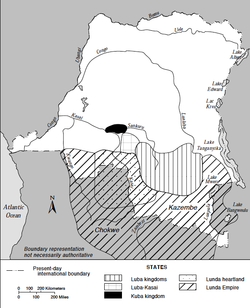This article includes a list of general references, but it lacks sufficient corresponding inline citations .(November 2016) |
Kingdom of Bakuba Kuba | |||||||||
|---|---|---|---|---|---|---|---|---|---|
| 1625–1884 | |||||||||
 Map of the Kuba Kingdom, Lunda Empire and Luba kingdoms in the Congo River Basin. | |||||||||
| Official languages | Bushong | ||||||||
| Government | Monarchy | ||||||||
| Nyim | |||||||||
• 1625 | Shyaam a-Mbul a Ngoong | ||||||||
| History | |||||||||
• Established | 1625 | ||||||||
• Disestablished | 1884 | ||||||||
| |||||||||
| Today part of | Democratic Republic of Congo | ||||||||
| History of the Democratic Republic of the Congo | ||||||||||||||||
|---|---|---|---|---|---|---|---|---|---|---|---|---|---|---|---|---|
 | ||||||||||||||||
| ||||||||||||||||
| ||||||||||||||||
| ||||||||||||||||
| See also: Years | ||||||||||||||||

The Kuba Kingdom, also known as the Kingdom of the Bakuba or Bushongo, is a traditional kingdom in Central Africa. The Kuba Kingdom flourished between the 17th and 19th centuries in the region bordered by the Sankuru, Lulua, and Kasai rivers in the heart of the modern-day Democratic Republic of the Congo.
Contents
- History
- Shyaam a-Mbul
- A new government
- Growth
- Apex
- Kuba culture
- Kuba art
- Kuba religion and mythos
- See also
- References
- Further reading
- External links
The Kuba Kingdom was a conglomerate of several smaller Bushong-speaking principalities as well as the Kete, Coofa, Mbeengi, and the Kasai Twa Pygmies. The original Kuba migrated during the 16th century from the north. Nineteen ethnic groups are included in the kingdom, which still exists and is presided over by the King (nyim).
